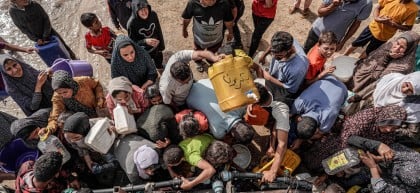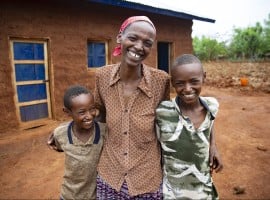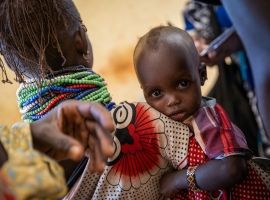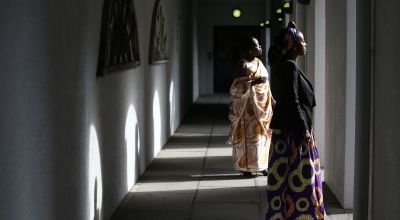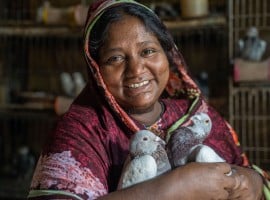
Read our 2024 annual report
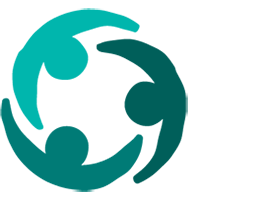
Knowledge Hub
And what they’re doing to change them.
Gender inequality is one of the major global barriers to ending extreme poverty. No country has yet to reach full gender equality, but many of those furthest behind are in Africa.
But what does that gender inequality look like on a day-to-day basis? Here, we take a look at 10 of the challenges women are currently facing in Africa. We also look at what Concern — and this year’s Women of Concern honouree, Berabose Aline Joyce — are doing to help millions of women and girls meet those challenges head on.
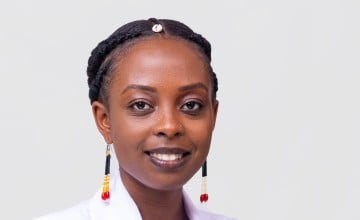
1. Getting access to general healthcare
In 46 high-income countries, women’s life expectancy at birth was over 80 years old. In the World Health Organisation’s African region, that life expectancy drops to 58 years. It’s often harder for women to get access to quality primary healthcare due to financial issues, a lack of time, or a lack of available services. Rural health systems in Africa are especially overwhelmed and often require a few days off to reach.
As a result, African women are more likely to die from communicable diseases like malaria, tuberculosis, and HIV. They also face higher risks for maternal mortality (more on that below) and nutritional deficiencies: Roughly half of all women in the world with anaemia live in Africa.
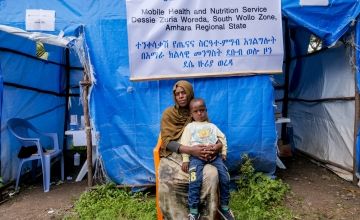
2. Reproductive health resources and rights
Women’s health in Africa becomes even more of a challenge when it comes to reproductive care. Sub-Saharan Africa has the largest populations of young women of reproductive age. It also has the highest number of births for women ages 15-19 — more than double the global rate.
According to the WHO, 17% of women in sub-Saharan Africa (and 23% of married women) would like to delay having children, but lack the resources for this. That leads to more high-risk pregnancies and dangerous methods of birth control.
This is one of the main areas of focus for LUNA, a femtech platform founded by Women of Concern honouree, Berabose Aline Joyce. From menstruation to menopause, Joyce hopes to help women gain greater access to safe reproductive healthcare.
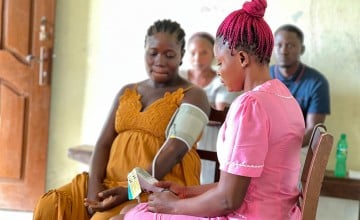
3. High maternal mortality rates
Without quality healthcare, reproductive rights, and antenatal care, maternal mortality rates go up. In 2023 over 700 women died every day from preventable causes due to pregnancy and childbirth. That’s more than a quarter of a million women.
All but one of the 10 worst countries to become a mother (based on maternal mortality rate) are in Africa. The rates are highest in Nigeria, with 993 deaths for every 100,000 live births. In Nigeria, those rates are increasing even as many other countries are seeing a decline.
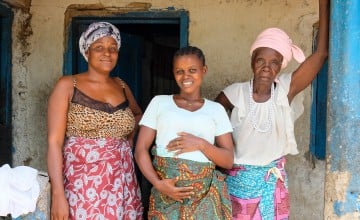
4. Gender-based violence
The African Union recognises gender-based violence as a “threat to human security, peace, and development.” 89,000 women around the world were intentionally killed in 2022. The majority were from countries in Africa.
Sub-Saharan Africa has the highest concentration of women who have experienced intimate partner violence (IPV), with many countries exceeding the regional average. The highest rates are found in the Democratic Republic of the Congo. Other countries well above the (already high) average include Liberia, South Sudan, Burundi, Rwanda, Kenya, Ethiopia, and Sierra Leone.
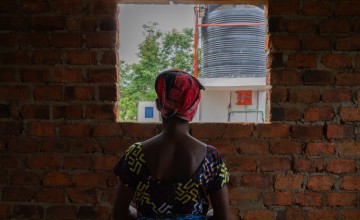
5. Mental health and wellbeing support
Globally, women are almost twice as likely as men to develop depression. That risk is higher for women living through traumatic events, which are prevalent across Africa. Ten countries are facing extreme or high levels of conflict according to ISS African Futures, with several more facing smaller levels of localised violence. The scars of recent conflicts are still felt across even more countries (including Liberia and Sierra Leone). In some communities, the World Economic Forum reports 20 to 25% of women screened meet the diagnostic criteria for depression.
Despite these figures (and more data surrounding GBV, postpartum depression, and other factors), mental health support is underfunded. Many governments have allocated just 1% of their national health budgets to address it. A survivor of the Rwandan genocide herself, Berabose Aline Joyce has seen this need firsthand. She founded The Circle, a healing and wellness space, to support Rwanda’s post-genocide generation through safe spaces, dialogue, and professional services.
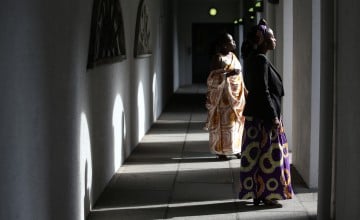
6. Economic exclusion
On average, women in Africa have limited access to credit and bank accounts and fewer property rights. In a 2022 speech, UN Women Executive Director Sima Bahous noted that women make up 58% of Africa’s self-employed population, but make 34% less than their male counterparts. In sub-Saharan Africa, women-owned businesses only win 1% of public procurement contracts.
For many women, simply owning a business is a far cry. Many work in informal and low-paying jobs because it’s the only work they can get. This is despite the proven data that economically empowering women benefits everyone.
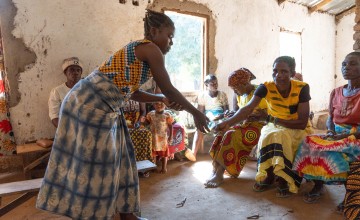
7. Unpaid domestic labour
African women spend more time engaged in unpaid domestic labour compared to men. One 2024 World Bank study suggests that this disparity is highest in Ethiopia, with high disparities in Malawi and Liberia as well. Social norms and systems leave most of the housekeeping and caregiving responsibilities on women’s shoulders, leaving them overburdened at home and often unable to reach their full earning potential.
Correcting this imbalance is part of Concern’s livelihoods programmes across Africa. In Malawi, our Umodzi programme required couples participating in income-building projects to also take part in gender equality workshops. These created better conditions at home that allowed women to thrive with their own small businesses, creating double incomes for families that needed them the most.
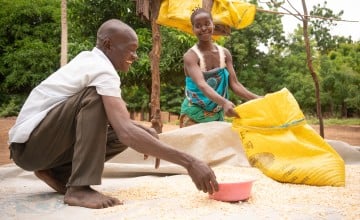
8. Getting an education
Many of the countries where it’s toughest to get an education are in Africa, and those challenges are higher for girls. A UNESCO report from sub-Saharan Africa found that just 66% of girls completed their primary education. Fewer still — 40% — completed lower-secondary education.
Child marriage is still a barrier to education. Many young girls drop out once they are married to stay home and start a family. They’re also more likely to be pulled out of school to save money or help their parents at home. Girls also face higher risks of abuse in the classroom (a form of GBV known as school-related gender based violence) and period poverty at schools without adequate facilities.
Concern’s education programmes bring gender equality in the classroom. We’ve addressed school-related GBV in Sierra Leone. In Kenya, we’ve broadened access to STEM education. In Malawi, we worked with parents’ groups to help the blackboard win over the bridal altar.
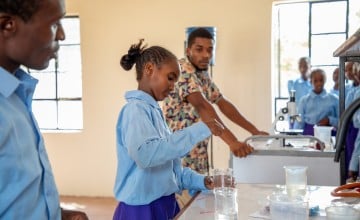
9. Legal rights for gender equality
In 2005, the Maputo Protocol went into effect in the African Union. Also known as the Protocol to the African Charter on Human and Peoples’ Rights on the Rights of Women in Africa, this bill guarantees comprehensive legal rights to women and codifies gender equality at the constitutional level.
It was a big step, but one that’s still being completed. As of this writing, 46 of the AU’s 55 member states have ratified the Maputo Protocol. Burundi, Chad, Niger, Somalia, and Sudan have all yet to sign it into law, disagreeing with some of the provisional rights. Yet even those countries that have ratified the Maputo Protocol still struggle with enforcing these rights. This leaves women in precarious legal territory, especially with issues including reproductive health, economic equality, widows’ rights, inheritances, and property ownership.
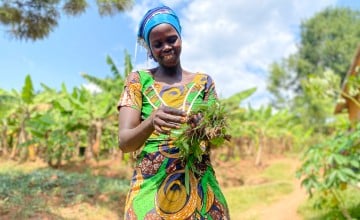
10. Political and leadership representation
Many of the challenges women are facing in Africa can be addressed is by giving women a seat at the decision-making table. This is true at the community as well as the national level with political and civic leadership.
This is an area of gender equality where Africa has made a lot of progress in 30 years. It saw its first female president in 1993 in Burundi, when Slyvie Kiningi took the office after the death of president Melchior Ndadaye. The first elected female president was Liberia’s Ellen Johnson Sirleaf, who took office in 2006. Other countries with recent or current female heads of state include Ethiopia, Mauritius, Tanzania, Central African Republic, and Malawi. In sub-Saharan Africa, women’s representation in lower houses of parliament has grown from 10% to 27%. In Rwanda, women form 61% of the country’s MPs.
However, other countries are struggling to gain parity (just 4% of Nigeria’s MPs are female), and many women in Parliament face uphill battles to gain consensus. It’s a hard road, but one that will be necessary for gender equality across the continent.
